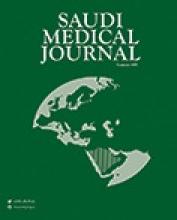Abstract
OBJECTIVE: To analyze the results of exercise tolerance test ETT of Saudi women and assess their exercise capacity.
METHODS: A hospital based retrospective cohort analysis was carried out on all Saudi women referred to the Cardiology Department for ETT from February 2005 to June 2007. They underwent symptom limited treadmill test according to the standard Bruce protocol with exercise electrocardiogram monitoring.
RESULTS: One hundred and seventy-six women were included in the study. Fifty-one 31.9% patients did not achieve target heart rate. The mean age ± SD was 48.3 ± 9.3 years. There was no association of age, diabetes mellitus, hypertension, positive family history of ischemic heart disease IHD and hyperlipidemia to achieve target heart rate p>0.05. Exercise time was influenced by diabetes mellitus p=0.054 and hyperlipidemia p=0.044. The mean exercise time ±SD was 5.15 ± 2.63 minutes and the mean exercise capacity ±SD was 6.29±2.52. metabolic equivalent. Sensitivity was 36.4% 95% CI 29.3-44.6, specificity 92.3% 95% CI 80.5-96.8, positive predictive value 26.7% 95% CI 21.3-31.4, negative predictive value 95.4% 95% CI 90.9-98.3, likelihood ratio for positive result was 4.7 95% CI 3.1-6.2 and likelihood ratio for negative result was 0.69 95% CI 0.48-0.81.
CONCLUSION: Exercise capacity of Saudi women is less when compared to similar studies in women from other regions. Exercise tolerance test can be used to rule out presence of IHD in Saudi women, but value of a positive test is less likely to predict the presence of IHD.
- Copyright: © Saudi Medical Journal
This is an open-access article distributed under the terms of the Creative Commons Attribution-Noncommercial-Share Alike 3.0 Unported, which permits unrestricted use, distribution, and reproduction in any medium, provided the original work is properly cited.






